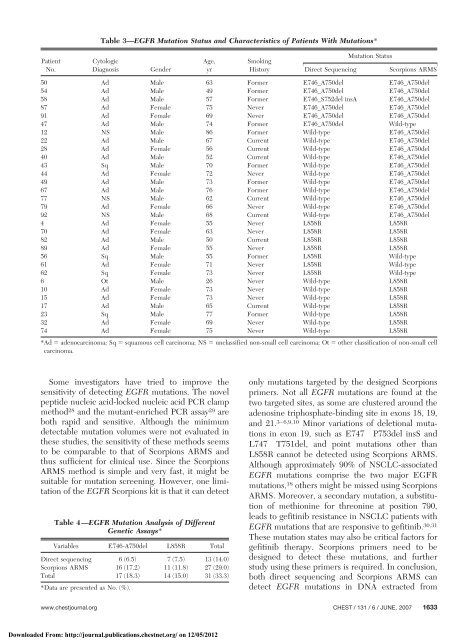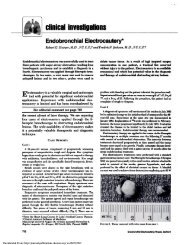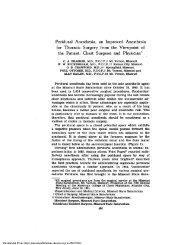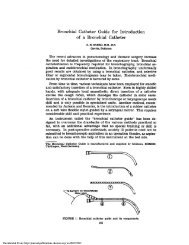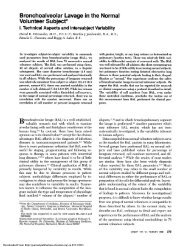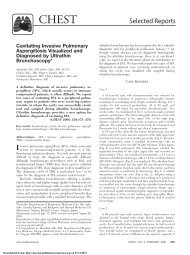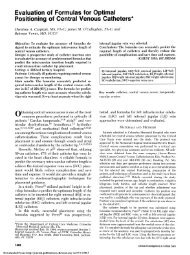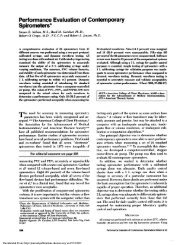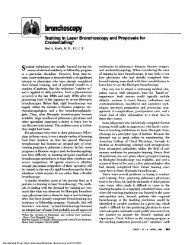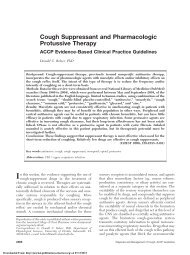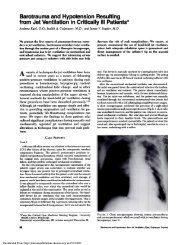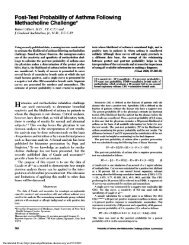Detection of Epidermal Growth Factor Receptor Mutation in ...
Detection of Epidermal Growth Factor Receptor Mutation in ...
Detection of Epidermal Growth Factor Receptor Mutation in ...
You also want an ePaper? Increase the reach of your titles
YUMPU automatically turns print PDFs into web optimized ePapers that Google loves.
Patient<br />
No.<br />
Table 3—EGFR <strong>Mutation</strong> Status and Characteristics <strong>of</strong> Patients With <strong>Mutation</strong>s*<br />
Cytologic<br />
Diagnosis Gender<br />
Age,<br />
yr<br />
Some <strong>in</strong>vestigators have tried to improve the<br />
sensitivity <strong>of</strong> detect<strong>in</strong>g EGFR mutations. The novel<br />
peptide nucleic acid-locked nucleic acid PCR clamp<br />
method 28 and the mutant-enriched PCR assay 29 are<br />
both rapid and sensitive. Although the m<strong>in</strong>imum<br />
detectable mutation volumes were not evaluated <strong>in</strong><br />
these studies, the sensitivity <strong>of</strong> these methods seems<br />
to be comparable to that <strong>of</strong> Scorpions ARMS and<br />
thus sufficient for cl<strong>in</strong>ical use. S<strong>in</strong>ce the Scorpions<br />
ARMS method is simple and very fast, it might be<br />
suitable for mutation screen<strong>in</strong>g. However, one limitation<br />
<strong>of</strong> the EGFR Scorpions kit is that it can detect<br />
Table 4—EGFR <strong>Mutation</strong> Analysis <strong>of</strong> Different<br />
Genetic Assays*<br />
Variables E746-A750del L858R Total<br />
Direct sequenc<strong>in</strong>g 6 (6.5) 7 (7.5) 13 (14.0)<br />
Scorpions ARMS 16 (17.2) 11 (11.8) 27 (29.0)<br />
Total 17 (18.3) 14 (15.0) 31 (33.3)<br />
*Data are presented as No. (%).<br />
Smok<strong>in</strong>g<br />
History<br />
<strong>Mutation</strong> Status<br />
Direct Sequenc<strong>in</strong>g Scorpions ARMS<br />
50 Ad Male 63 Former E746_A750del E746_A750del<br />
54 Ad Male 49 Former E746_A750del E746_A750del<br />
58 Ad Male 57 Former E746_S752del <strong>in</strong>sA E746_A750del<br />
87 Ad Female 75 Never E746_A750del E746_A750del<br />
91 Ad Female 69 Never E746_A750del E746_A750del<br />
47 Ad Male 74 Former E746_A750del Wild-type<br />
12 NS Male 86 Former Wild-type E746_A750del<br />
22 Ad Male 67 Current Wild-type E746_A750del<br />
28 Ad Female 56 Current Wild-type E746_A750del<br />
40 Ad Male 52 Current Wild-type E746_A750del<br />
43 Sq Male 70 Former Wild-type E746_A750del<br />
44 Ad Female 72 Never Wild-type E746_A750del<br />
49 Ad Male 73 Former Wild-type E746_A750del<br />
67 Ad Male 76 Former Wild-type E746_A750del<br />
77 NS Male 62 Current Wild-type E746_A750del<br />
79 Ad Female 66 Never Wild-type E746_A750del<br />
92 NS Male 68 Current Wild-type E746_A750del<br />
4 Ad Female 55 Never L858R L858R<br />
70 Ad Female 63 Never L858R L858R<br />
82 Ad Male 50 Current L858R L858R<br />
89 Ad Female 55 Never L858R L858R<br />
56 Sq Male 55 Former L858R Wild-type<br />
61 Ad Female 71 Never L858R Wild-type<br />
62 Sq Female 73 Never L858R Wild-type<br />
6 Ot Male 26 Never Wild-type L858R<br />
10 Ad Female 73 Never Wild-type L858R<br />
15 Ad Female 73 Never Wild-type L858R<br />
17 Ad Male 65 Current Wild-type L858R<br />
23 Sq Male 77 Former Wild-type L858R<br />
32 Ad Female 69 Never Wild-type L858R<br />
74 Ad Female 75 Never Wild-type L858R<br />
*Ad � adenocarc<strong>in</strong>oma; Sq � squamous cell carc<strong>in</strong>oma; NS � unclassified non-small cell carc<strong>in</strong>oma; Ot � other classification <strong>of</strong> non-small cell<br />
carc<strong>in</strong>oma.<br />
only mutations targeted by the designed Scorpions<br />
primers. Not all EGFR mutations are found at the<br />
two targeted sites, as some are clustered around the<br />
adenos<strong>in</strong>e triphosphate-b<strong>in</strong>d<strong>in</strong>g site <strong>in</strong> exons 18, 19,<br />
and 21. 3–6,9,10 M<strong>in</strong>or variations <strong>of</strong> deletional mutations<br />
<strong>in</strong> exon 19, such as E747 P753del <strong>in</strong>sS and<br />
L747 T751del, and po<strong>in</strong>t mutations other than<br />
L858R cannot be detected us<strong>in</strong>g Scorpions ARMS.<br />
Although approximately 90% <strong>of</strong> NSCLC-associated<br />
EGFR mutations comprise the two major EGFR<br />
mutations, 18 others might be missed us<strong>in</strong>g Scorpions<br />
ARMS. Moreover, a secondary mutation, a substitution<br />
<strong>of</strong> methion<strong>in</strong>e for threon<strong>in</strong>e at position 790,<br />
leads to gefit<strong>in</strong>ib resistance <strong>in</strong> NSCLC patients with<br />
EGFR mutations that are responsive to gefit<strong>in</strong>ib. 30,31<br />
These mutation states may also be critical factors for<br />
gefit<strong>in</strong>ib therapy. Scorpions primers need to be<br />
designed to detect these mutations, and further<br />
study us<strong>in</strong>g these primers is required. In conclusion,<br />
both direct sequenc<strong>in</strong>g and Scorpions ARMS can<br />
detect EGFR mutations <strong>in</strong> DNA extracted from<br />
www.chestjournal.org CHEST / 131 /6/JUNE, 2007 1633<br />
Downloaded From: http://journal.publications.chestnet.org/ on 12/05/2012


